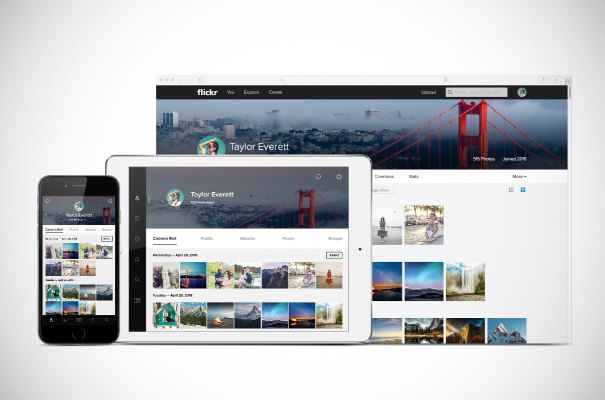Flickr today is rolling out a revamped version of its website, software applications for desktop and mobile, as well as its search service, in what’s perhaps the biggest update since the company’s decision to increase users’ free storage space on its photo-sharing site to 1 TB back in 2013.
The new series of upgrades are focused on making every aspect of the service easier to use and more efficient, including uploads, edits, organization, search and sharing. Some of the more notable changes include the addition of auto-tagging and image recognition capabilities, the latter of which will now see Flickr competing more directly with Google’s photo service, Google+ Photos.
These new features have been in development for some time, as Flickr first realized that it would need to roll out better tools for its end users following the announcement of the free terabyte of storage, which the company claims led to a large uptake in user sign-ups. The company now claims to have 100 million members on its service.
In many cases, the changes address concerns users have had with the aging service, whose development had lagged for years following its acquisition by Yahoo and the subsequent departure of its founders. Under CEO Marissa Mayer’s regime, however, Flickr finally began to receive more attention, beginning with the initial revamp in 2013, and followed by the rollout of updated mobile applications.
Today’s upgrades are the first big release to arrive since Mayer’s shuffles to Yahoo’s leadership team, which included bringing in new Flickr heard Jeff Bonforte, previously the CEO of email startup Xobni which Yahoo acquired a couple of years prior.
New Desktop Software
Nearly every aspect to Flickr’s service has been updated today, beginning with the way that users upload photos to Flickr’s cloud. The company is releasing new desktop software applications for both Mac and Windows which allow users to upload photos from their PC, SD cards, external hard drives, and other devices. As the uploads are taking place, the new photos are immediately displayed in Flickr’s new Camera Roll view on its website and apps, which now serves as the site’s new interface for interacting with your photos.
The photos are also automatically synced across all devices, de-duped, and marked as private until you specify otherwise.
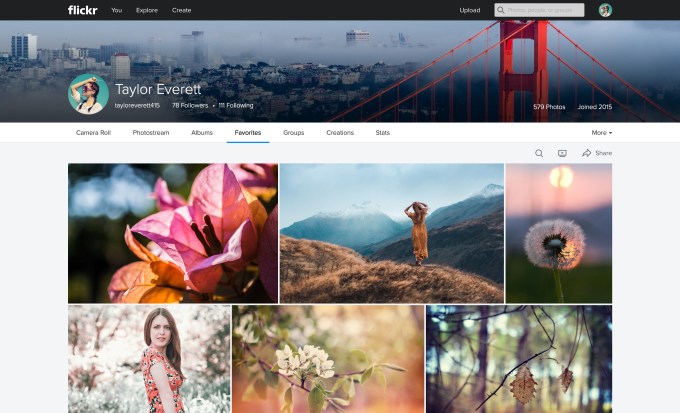
A “Camera Roll in the Cloud”
A “Camera Roll in the cloud” is how the feature’s Product Lead Aditya Kashyap describes Flickr’s updated interface. Outside of search, it’s the area that’s received the most attention in terms of added features and functionality. The idea is to give users an improved toolset that allows them to more easily organize and edit photos, Kashyap says, and it offers a number of different viewing options for filtering and sorting photos, as well as organizing them, ahead of sharing them more publicly.
For instance, the Camera Roll lets you view your photos by either the date uploaded or the date taken, and then groups photos into separate sections based on their timestamps. That way you can easily share all your photos from a particular timeframe with just a click. You can also click to select photos to share, or even use your mouse to draw a box around a group of photos – a feature that can speed up the selection process quite a bit. And you can now download multiple photos as .zip file.
[gallery ids="1155703,1155705,1155704,1155702"]
With a group of photos selected, you can edit the entire batch’s metadata, like the date taken, the photos’ privacy (how visible it is on Flickr’s service), the licensing, and other items. You can also share that batch of photos via email, Instagram, Facebook and
more, as well as add identifying tags.
Of course, manually tagging photos is something of a holdover from a prior era of photo-sharing – one that made more sense before users carried around smartphone cameras in their pocket and used apps (like Flickr’s) to automatically upload every photo from their device to an online storage site.
“In world where you’re uploading thousands of photos, it’s impractical to expect everyone to tag their photos,” notes Andrew Stadlen, Director of Product Management, for Flickr’s search and image recognition technology.
“Magic View”
That’s why the new “Magic View” feature is one the better additions arriving today. This feature, as with Flickr’s upgraded search service, takes advantage of computer vision technology to automatically recognize what’s in your photos and tag them accordingly. That is, Flickr now knows if your photos are landscapes, screenshots, text photos, photos of people, children, animals, vehicles, architecture, sunsets, water, and much more. At launch, there are 60 some categories like this that Flickr can identify, but the team has built thousands which are still in testing.
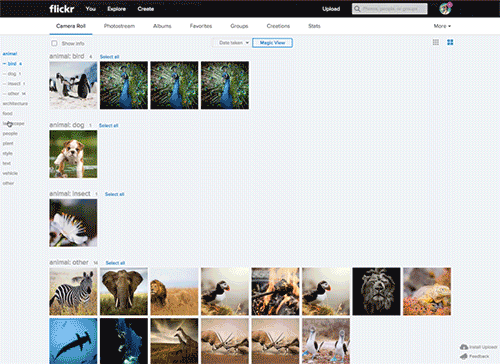
While not perfect, the algorithms used are continually improving, Stadlen explains. For example, if Flickr misidentifies a motorcycle as a bicycle and a user corrects that, the service will learn from that input so it won’t make the same mistake again. “The technology is always improving,” he says.
Built on the same computer vision technology that also powers services like Google+ Photos, the advantage to Flickr’s image recognition tech is that it’s actually built into the product’s user interface. While many people today don’t realize that you can search your Google+ Photos for terms like “sunsets” or “New York” or “kids,” these sorts of things are actually called out in Flickr’s new “Magic View” interface. That is, you’re able to click on the left-side navigation to display a particular category’s photos.
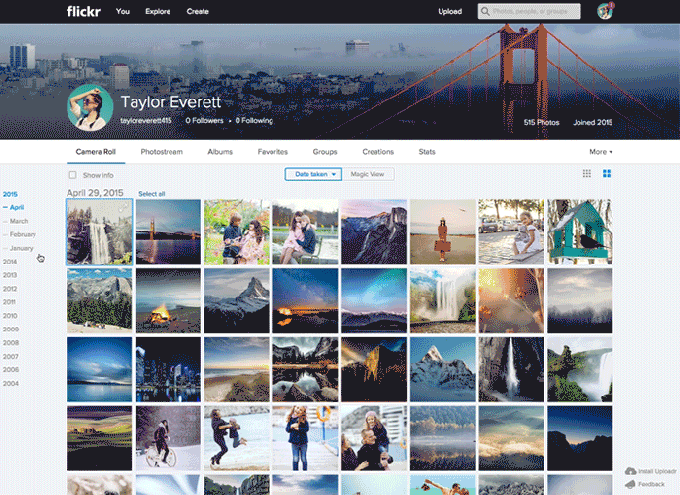
New Features: Unified Search, Image Recognition, Search By Color And More
This same computer vision technology also powers Flickr’s new search service, which is another one of the larger improvements. Because Flickr is now automatically recognizing photos and adding tags, search is able to return an improved set of results. That means that, as on Google+, users can search for the people, places, and things Flickr can identify. In addition to broader categories, the service is also smarter about understanding word pairings.
For example, a search on Flickr before today for “pumpkin pie” would return a lot of images of just pumpkins. But now, says Stadlen, it can understand that the two words have a different meaning when combined. Flickr is capable of understanding “millions” of phrases, he says – a huge corpus built off of Wikipedia data. Plus, you can search by other combinations – like type of photo and time frame. For instance: “Halloween 2013” and “kids.”
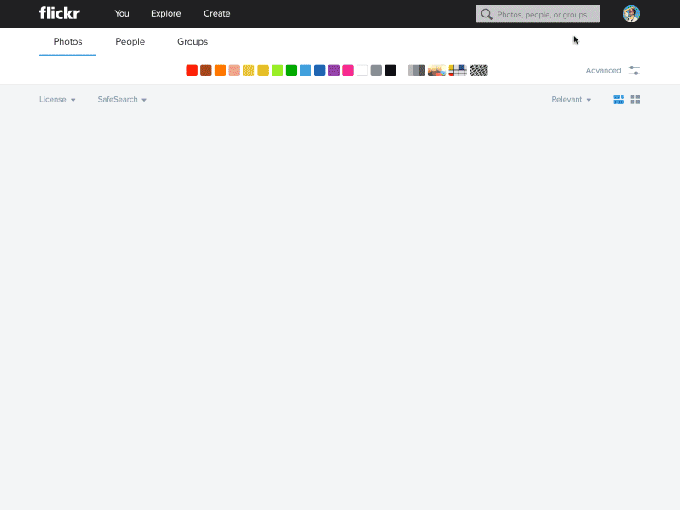
In addition to its image recognition capabilities, Flickr also lets you tap into advanced search tools for searching by various metadata like date taken or uploaded, minimum size, orientation and more. You can also filter search results by “style,” like minimalist, black and white, shallow depth of field, or patterns. And Flickr lets you search by color, too, using a color picker at the top of the site which can be combined with search terms. That way, you could search for “sunset” and then filter results by the color of the sky (e.g., orange, pink, red, purple, etc.)
One thing Flickr is not yet doing is facial recognition. While the service can identify that photos have faces, it hasn’t rolled out the ability to identify who’s faces they are at this point.
Another big change to search is that it’s now a unified experience – that is, when you perform any search on Flickr, you’re first shown a group of your own photos that match your query, followed by a group of photos from the people you follow on the service, and then everyone else’s photos are below. Photos can also be viewed in a “justified” format or as smaller thumbnails, to make scrolling through large batches quicker.
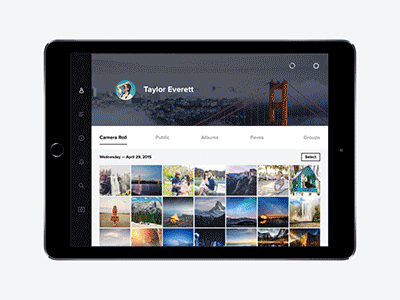
New Mobile Apps
Most of the above changes are also present on Flickr’s updated mobile apps rolling out today, except for the “Magic View,” which is unfortunately web-only for now. The idea is that the mobile apps should offer the same feature set as you’d see on the web, in order to offer a seamless experience as you switch between devices.
The apps and the desktop website both support simplified sharing. On the web, you can drag your cursor around a group of photos, as noted above, while on mobile, you use your finger to select a group of photos. After making the selection, you can then share to social media or email. One neat feature is that you can expire the sharing link whenever you want, in case you don’t want a group of photos accessible indefinitely.
[gallery ids="1154643,1154641,1154640,1154639,1154638,1154637,1154636,1154635,1154634,1154633"]
In addition to mirroring the feature set introduced on the web, the mobile experience has been redesigned as well, with access to the Camera Roll view, a nav bar that disappears as you scroll, a redesigned feed, and support for non-destructive editing (meaning you can revert back to the original at any time.)
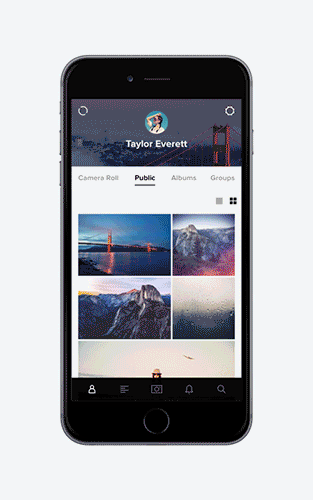
While the new features are welcome additions for regular Flickr users, the company’s delay to roll out improvements like this – things that have been technically feasible for years – has allowed competitors to establish larger footholds in the photo-sharing market. While Google competes on the image recognition front, Flickr also faces challenges from companies like Apple, Dropbox, Amazon and a plethora of startups which also offer tools for automated uploads, photo organization, edits, sharing and more. Flickr of course still has a large user base, and it no longer has to monetize just by selling additional storage – which gives it an advantage over some. But new tools alone may not be enough for Flickr to recapture the mindshare and momentum it had in its earlier days.
[gallery ids="1155701,1155709,1155708,1155707,1155706,1155705,1155704,1155703,1155702,1155700,1155699"]
